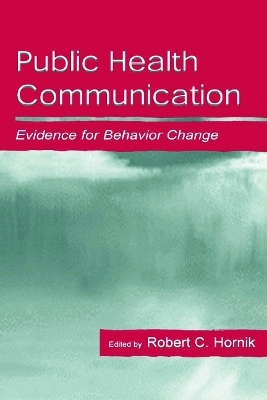
Public Health Communication
Routledge (Verlag)
978-0-8058-3176-4 (ISBN)
This volume argues the case that public health communication has affected health behavior. It brings together 16 studies of large-scale communication in a variety of substantive health areas--tobacco, drugs, AIDS, family planning, heart disease, childhood disease, highway safety--prepared by the authors who did the original research. These studies show important effects and illustrate the central conditions for success. The book also includes complementary analytic chapters which provide a meta-analysis of published results, some approaches to developing communication interventions, and alternative methods for evaluation of public health communication projects.
Including studies based on communication programs in the United States, as well as projects done elsewhere in the world, including Europe, Africa, Asia and Latin America, this book:
*offers a broad presentation of the alternative research designs that have been used to evaluate public health communication programs;
*includes a great range of approaches from field experiments and natural experiments to simple before-after and complex time series designs, using data gathered from individuals and from archives; and
*utilizes an innovative perspective on how to exercise public health communication from a leading and thoughtful practitioner.
As such, it is required reading for scholars, students, practitioners, and policymakers in public health, health communication, health psychology, and related areas.
Robert Hornik
Contents: Preface. Introduction. R. Hornik, Public Health Communication: Making Sense of Contradictory Evidence. Part I: Deliberate Trials.J.K. Worden, B.S. Flynn, Using Mass Media to Prevent Cigarette Smoking. P. Palmgreen, L. Donohew, E.P. Lorch, R.H. Hoyle, M.T. Stephenson, Television Campaigns and Sensation Seeking Targeting of Adolescent Marijuana Use: A Controlled Time Series Approach. J.P. Pierce, P. Macaskill, D. Hill, Long-Term Effectiveness of the Early Mass Media Led Antismoking Campaigns in Australia. Part II: Evaluations of Full-Scale Interventions.E.J. Roccella, The Contributions of Public Health Education Toward the Reduction of Cardiovascular Disease Mortality: Experiences From the National High Blood Pressure Education Program. A.F. Williams, J.K. Wells, D.W. Reinfurt, J.K. Wells, Increasing Seat Belt Use in North Carolina. J.P. Pierce, S. Emery, E. Gilpin, The California Tobacco Control Program: A Long-Term Health Communication Project. M. Siegel, L. Biener, The Impact of Antismoking Media Campaigns on Progression to Established Smoking: Results of a Longitudinal Youth Study in Massachusetts. K. Wellings, Evaluating AIDS Public Education in Europe: A Cross-National Comparison. S. McCombie, R.C. Hornik, J.K. Anarfi, Effects of a Mass Media Campaign to Prevent AIDS Among Young People in Ghana. D. Hill, V. White, R. Marks, R. Borland, Changes in Sun-Related Attitudes and Behaviors, and Reduced Sunburn Prevalence in a Population at High Risk of Melanoma. D.L. Kincaid, A.P. Merritt, L. Nickerson, S. de Castro Buffington, M.P.P. de Castro, B.M. de Castro, Impact of a Mass Media Vasectomy Promotion Campaign in Brazil. S. Zimicki, R.C. Hornik, C.C. Verzosa, J.R. Hernandez, E. de Guzman, M. Dayrit, A. Fausto, M.B. Lee, Improving Vaccination Coverage in Urban Areas Through a Health Communication Campaign: The 1990 Philippines Experience. R.C. Hornik, J. McDivitt, S. Zimicki, P.S. Yoder, E. Contreras-Budge, J. McDowell, M. Rasmuson, Communication in Support of Child Survival: Evidence and Explanations From Eight Countries. Part III: Media Coverage and Health Behavior.D.P. Fan, Impact of Persuasive Information on Secular Trends in Health-Related Behaviors. S.B. Soumerai, D. Ross-Degnan, J.S. Kahn, The Effects of Professional and Media Warnings About the Association Between Aspirin Use in Children and Reye's Syndrome. K. Viswanath, J.R. Finnegan, Jr., Reflections on Community Health Campaigns: Secular Trends and the Capacity to Effect Change. Part IV: Cross-Case Overviews.A.L. McAlister, M. Fernandez, "Behavioral Journalism" Accelerates Diffusion of Healthy Innovations. W. Smith, From Prevention Vaccines to Community Care: New Ways to Look at Program Success. L.B. Snyder, M.A. Hamilton, A Meta-Analysis of U.S. Health Campaign Effects on Behavior: Emphasize Enforcement, Exposure, and New Information, and Beware the Secular Trend. R. Hornik, Epilogue: Evaluation Design for Public Health Communication Programs.
| Erscheint lt. Verlag | 12.2.2002 |
|---|---|
| Reihe/Serie | Routledge Communication Series |
| Verlagsort | New York |
| Sprache | englisch |
| Maße | 152 x 229 mm |
| Gewicht | 725 g |
| Themenwelt | Medizin / Pharmazie ► Gesundheitswesen |
| Studium ► Querschnittsbereiche ► Prävention / Gesundheitsförderung | |
| Sozialwissenschaften ► Kommunikation / Medien ► Kommunikationswissenschaft | |
| ISBN-10 | 0-8058-3176-2 / 0805831762 |
| ISBN-13 | 978-0-8058-3176-4 / 9780805831764 |
| Zustand | Neuware |
| Haben Sie eine Frage zum Produkt? |
aus dem Bereich


